Kavenz VHP 16 V7
Wheel Size: 29’’ front / 27.5’’ or 29’’ rear
Travel: 160 mm rear / 160–180 mm front
Geometry Highlights:
- Sizes offered: S, M, L, XL, 2XL, 3XL
- Headtube angle: 64°
- Reach: 480 mm (size Large)
- Chainstay length: 425 mm, with +0, +10, and +20 mm dropout options available
Frame Material: Aluminum
Price: €2,795 incl. VAT / $2,655 USD excl. VAT (frame only, no shock)
Blister’s Measured Weight 34.6 lb / 15.85 kg (Size L, 125 mm headtube, as built)
Reviewer: 6’, 160 lb / 183 cm, 72.6 kg
Test Locations: Washington, Oregon
Test Duration: 3 months

Intro
Born from the 77-Designz component brand, Kavenz has done things a bit differently from the start. With the V7, Kavenz has transformed the VHP (“virtual high pivot”) frame design into a modular platform that can become six different bikes with the simple swap of a shock and shock mount — from the 120 mm VHP 12 aimed at the short travel crowd to the 184 mm travel VHP 18 Downhill bike.
The VHP 16 is the heart of the platform, and is a bike we tested (and found quite impressive) back in 2022. The updated version keeps a similar frame silhouette and design but adds some new features and a lot of adjustment options. Let’s dig in to find out what Kavenz has cooked up.

The Frame
Kavenz was notably transparent in the development of the initial VHP 16 frame design, with their social media channels featuring videos of frame testing and a deeper look into the intricacies and challenges of the ground-up frame design. Kavenz hasn’t changed the basic silhouette of the VHP platform since that initial VHP 16 development, keeping a fairly traditional front triangle shape (hooray for easy water bottle fitment) paired with a high pivot suspension design and elevated chainstays. The frame is still made in Germany and uses 7020 aluminum for the front triangle and 6061 aluminum for the rear.
Kavenz is quite forthcoming about the specific metrics of the suspension layout and kinematics. We covered many of those traits quite deeply in our review of the prior version of the VHP 16, but in short, Kavenz has used a Horst Link layout in concert with a high pivot design in order to get some of the rearward axle path benefits of a high pivot while avoiding some of the drawbacks that come with the very high anti-rise often accompanying high single pivot designs.
The prior VHP 16 we tested had an impressive combination of suspension traits that made for an efficient climber and confident but playful descender. Kavenz has kept the same suspension kinematics with the VHP 16, with anti-squat sitting at a high 140% at sag and anti-rise at just over 90% throughout the travel. The use of an idler allows that high anti-squat to be accompanied with fairly low pedal kickback, maxing out at 6.5°. The rearward axle path creates about 15 mm of rearward axle movement, peaking 100 mm into the rear wheel travel — running the MX configuration bumps that rearward axle movement to just over 20 mm. The leverage curve remains the same as the prior VHP 16, going from 2.85:1 to 2.2:1 in a fairly linearly progressive fashion. One structural update here is that Kavenz has redesigned the rocker link to drop some weight with this V7 iteration, with that link now weighing in at just 270 grams.
Note that the numbers above are for the 29” version of the VHP 16. Depending on your selected suspension characteristics do change in the other permutations of the frame, such as the VHP12 or VHP18, but Kavenz publishes those curves as well within their charts if you want to geek out further — see those graphs below.
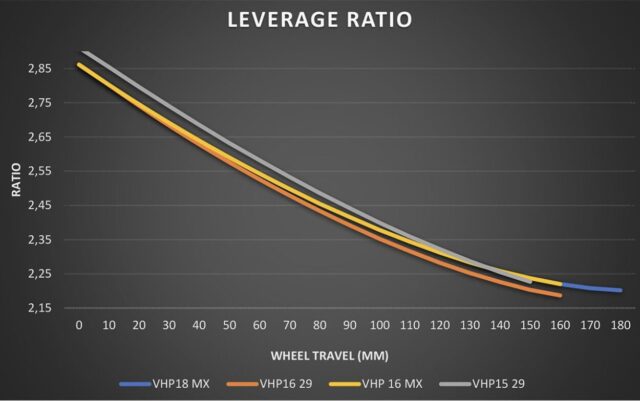
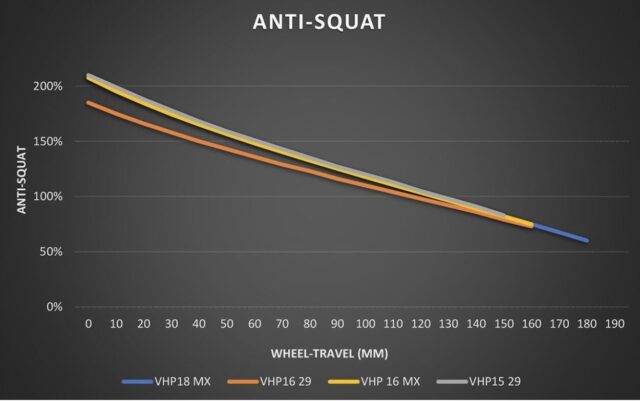
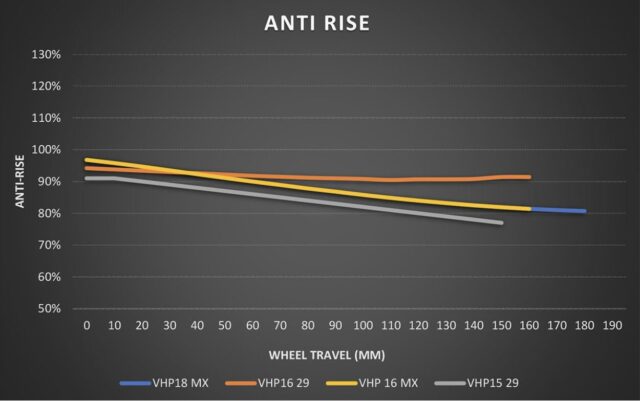
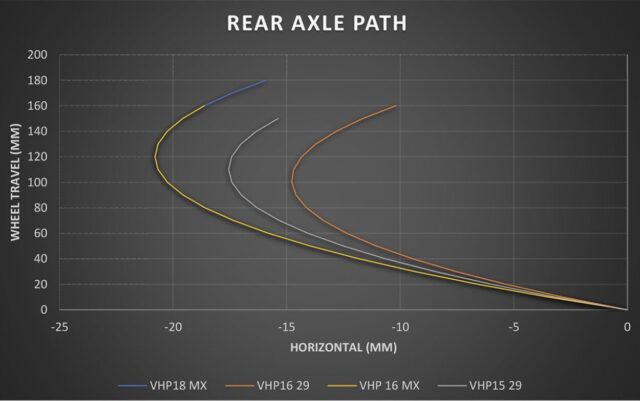

Speaking of those other iterations of the VHP frame, Kavenz has managed to pack a ton of modularity into the frame design. The VHP 16 has, as the name suggests, 160 mm of travel — the VHP12, VHP15, and VHP18 all feature 120 mm, 150 mm, and 184 mm of travel, respectively. The VHP 16 and VHP18 are available in MX versions as well with a 27.5” rear wheel. In all cases, the front and rear triangles are the same, with the changes being managed by swapping to a different shock stroke and/or a different lower shock mount. The fact that Kavenz offers this level of customization with such a (relatively) minor change is very unique and creates a whole lot of potential within a single frame. As an example, a rider who is so inclined could keep the bike in VHP 16 mode as a daily driver, but then make a simple swap to a dual crown fork, longer stroke shock, and different shock mount for smashing bike park laps.
Beyond the numerous travel configurations, Kavenz also now offers interchangeable dropouts, which we’ll talk about in the geometry section below. Those updated dropouts use a UDH interface, making sourcing derailleur hangers quite simple while also allowing for the use of SRAM’s T-Type groupsets. The idler pulley has been updated from 14T to 16T, likely reducing drag a bit, and it’s also made of a longer-lasting steel for lower maintenance down the road. The bearings used on the frame are now Enduro’s higher-end Black Oxide offering, which should help keep things rolling smoothly for a bit longer in harsh climates.
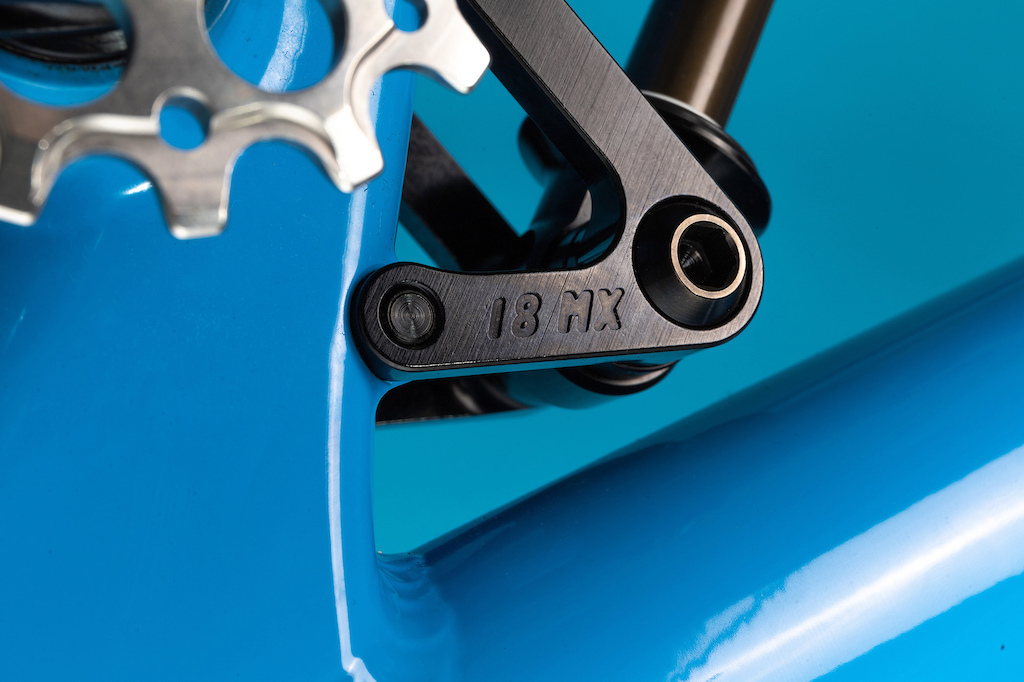
Fit & Geometry
Kavenz has largely stuck with the same geometry as the prior version we tested, and from our perspective that’s a good thing. The big update here is the modular dropout system, which allows for +0, +10, and +20 mm dropout options. Despite the 15 mm of rearward axle path due to the high pivot placement, the 425 mm chainstays on the prior version we tested were quite short, and while the rear center didn’t feel particularly short on the trail, that shorter rear center likely contributed to the bike’s notably quick handling. From a baseline of 425 mm (in the 29er setting, or 419 mm in the MX one), the chainstays have held steady with the +0 mm dropout option and grown substantially with the +10 and +20 mm ones. This means more proportionate rear centers are now possible in larger sizes, but it also opens the door to lots of customization for riders who might prefer a longer, more stable-feeling rear center.

In addition to the six sizes offered (XS – 3XL), Kavenz still offers semi-custom geometry at no additional upcharge to help riders find exactly the fit they’re looking for. The stock size Large, for example, is very much in line with other modern Enduro bikes: 480 mm reach, 639 mm stack, 450mm seat tube, 64° head angle, and 435 mm chainstays. Customers who like that reach measurement but are looking for something slightly different can choose a longer or shorter seat tube, choose a longer or shorter dropout, or bump the stack measurement by going for a 125 mm head tube instead of the standard 110 mm one on the Large.
When accounting for the different travel and wheel size options, Kavenz claims that the frame offers 576 different possible configurations of travel, rear center, front center, stack, and seat tube length. That is certainly impressive, but because Kavenz relies on conventional sizing as a baseline, it also makes the level of customization feel quite approachable.
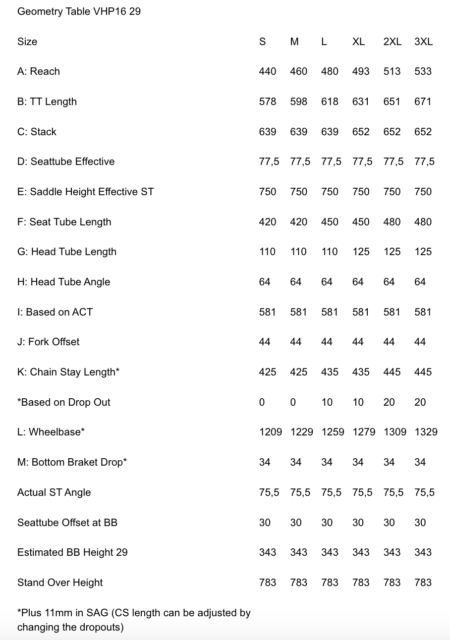
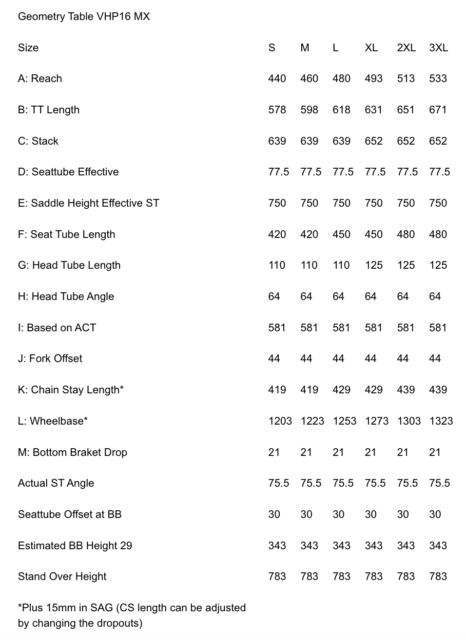
The Build
Kavenz doesn’t currently offer complete builds — it’s a frame-only affair, with the option to purchase a shock and/or fork to complete the package. Kavenz offers Fox, EXT, and Intend shock options along with Fox forks; check out their website for the details.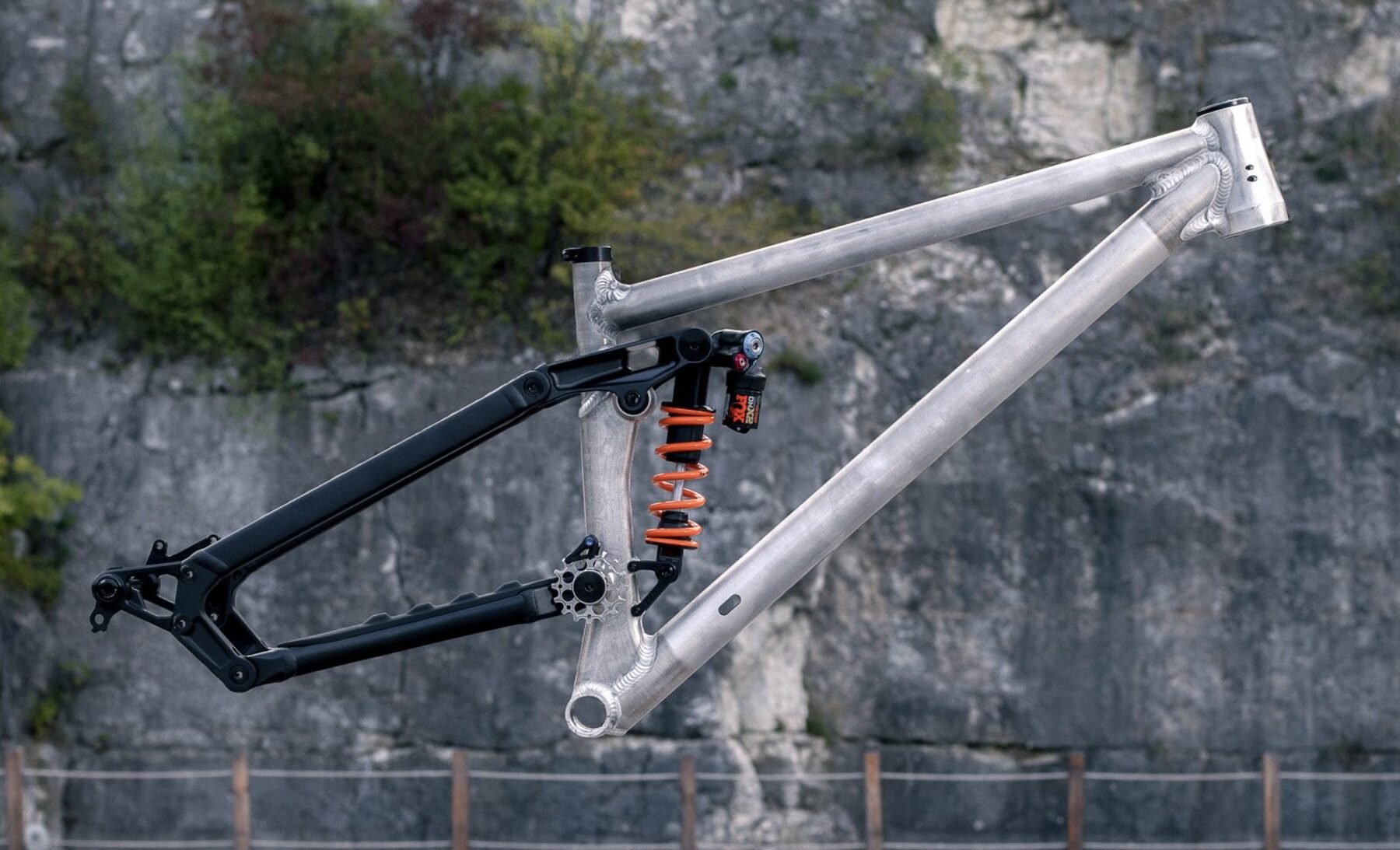
FULL REVIEW
Kavenz is a small German manufacturer with some very big ideas. Started by the man behind component company 77-Designz, Kavenz blazed a new trail by being rather transparent about the development of the first iteration of the VHP 16, giving bike nerds a better idea of what it really takes to develop, test, and ultimately sell a frame. (Check out Ep.117 of Bikes & Big Ideas with Kavenz founder Giacomo Großehagenbrock for a whole lot more on that.)
The high pivot VHP 16 is now in its 7th iteration, and this latest version brings adjustable chainstays, a revised idler, mixed wheel compatibility, and a whole lot more to the table. The VHP 16 V6 offered an admirable all-around performance and set a high bar within the high pivot genre of Enduro bikes, so we were very keen to see what Kavenz had cooked up with the new version.

Fit & Sizing
Zack Henderson (6’, 160 lb / 183 cm, 72.6 kg): As we discussed in our First Look, Kavenz takes the unusual step of offering semi-custom geometry at no additional cost. Given my stature and preference for slightly taller stack heights, I opted for what I might describe as the “Large Plus” — the baseline Large frame with a longer 125 mm headtube from the XL to bring the stack up to a rather tall 652 mm (the Large frame defaults to a 110 mm headtube). For my neck of the woods, taller stack heights allow for a more confident stance in steep terrain without requiring a tower of spacers or ultra-high-rise bars. By using the same top tube as a size Large, the taller headtube of the “Large Plus” actually results in the reach shrinking a bit to 473 mm — that’s a bit shorter than my typical preference, but the overall fit is helped by the taller stack.
Focusing on the front half of the bike, the Kavenz felt quite natural from the get-go. Sure, it helps that I was running my own cockpit of choice, but the reach, stack height, and seated pedaling position all felt quite natural. If anything, the seated pedaling position feels a bit short with the effective top tube length measuring 618 mm, which is a few millimeters short of my typical Goldilocks length. I started with a 40 mm stem, but found that a 45 mm stem length went a long way to giving me a touch more room without messing with the handling too much.
Part of that shorter-feeling seated position is also due to the VHP 16’s steeper 77.5° effective seat tube angle, which is quite nice on steeper climbs. That’s quite close to the 75.5° actual seat tube angle, and the small difference there means that running the seat a bit higher or lower than Kavenz’s 750 mm reference seat height won’t cause the effective seat tube angle to fluctuate all that much. That’s good news for long-legged riders who can find their seated position feeling a bit more off the back than advertised due to slacker actual seat angles on other bikes.
We’ll cover this in detail below in the on-trail impressions below, but Kavenz’s swappable dropouts give a lot of adjustability to the VHP 16’s chainstay length. In addition to equipping us with shock mounts to run both 29” and 27.5” rear wheels, Kavenz provided +10 and +20 mm dropouts. This gave us the ability to test 435 and 445 mm chainstay lengths in 29” mode, and 429 and 439 mm chainstay lengths in mixed wheel guise.
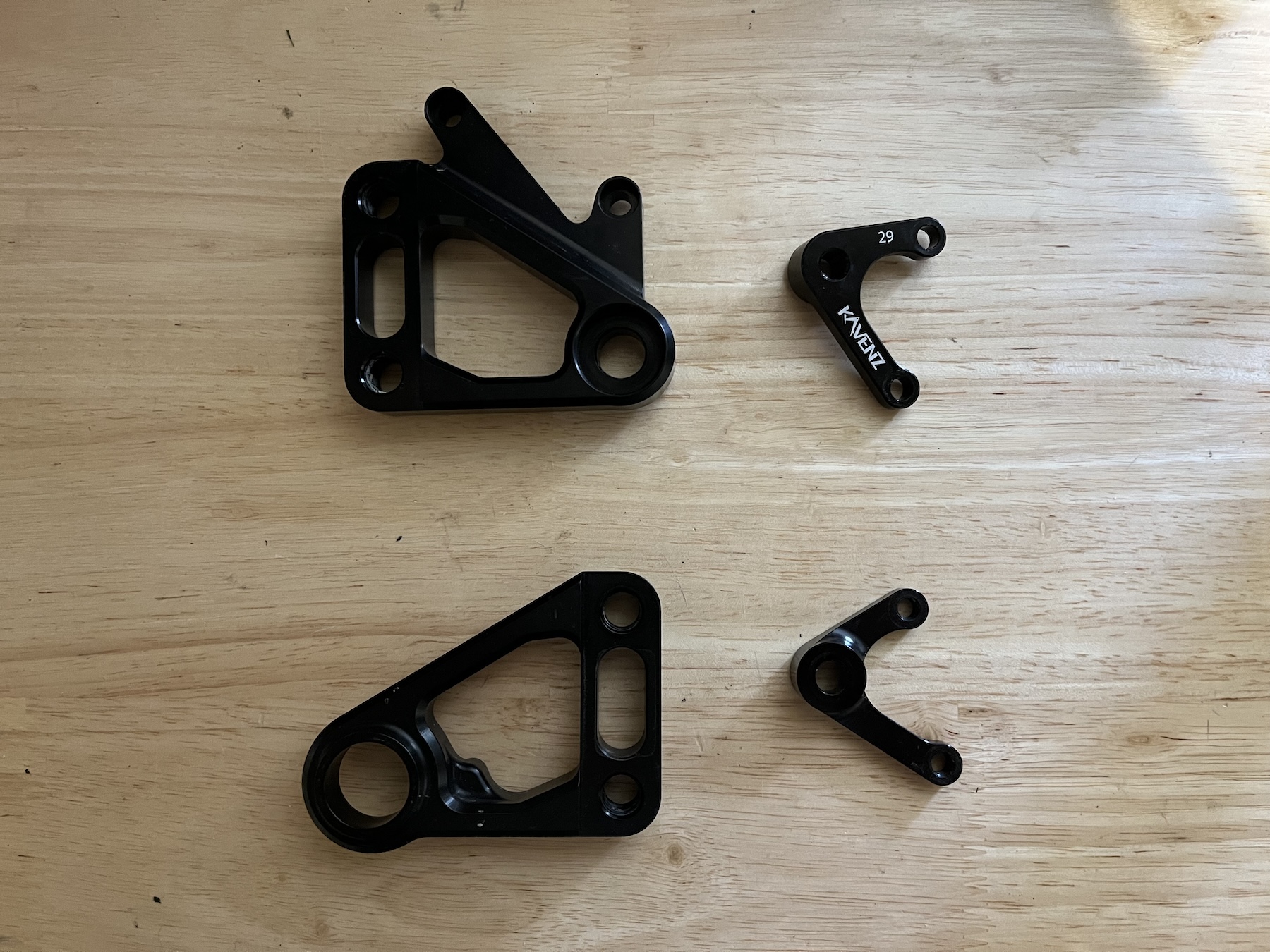
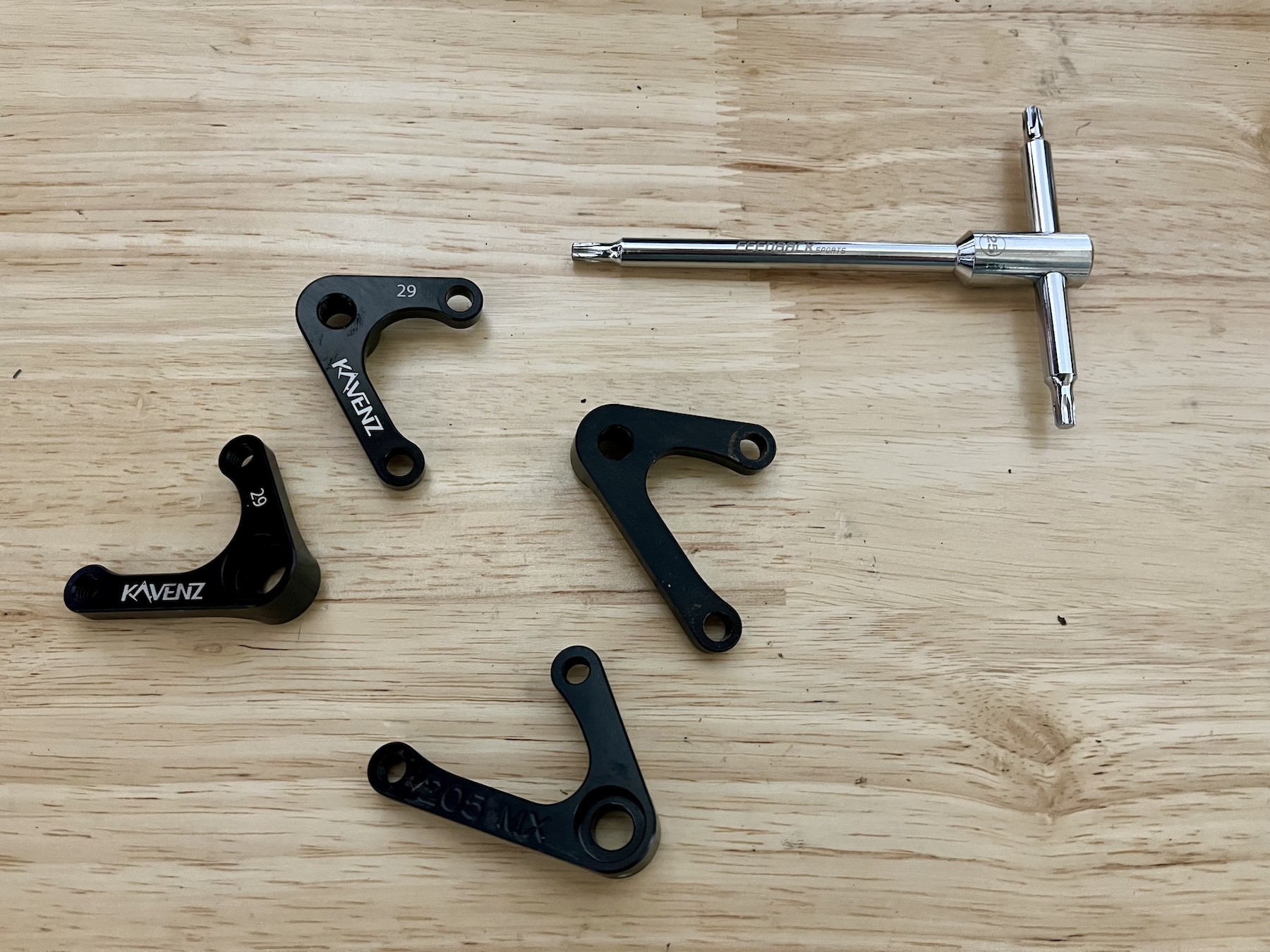
All told, the “Large Plus” sizing that I opted for proved to be the right call. I think I certainly could have ridden an XL without issue, but between my preference for a 480 mm reach and the growing rear center that a high pivot placement generates (+15 and +21 mm in the the 29” and 27.5” modes, respectively), the Large frame with a taller 125 mm headtube ended up feeling like the right balance of maneuverability and stability in a well-rounded Enduro bike.
Climbing
There is a common misconception that high-pivot bikes are inherently inefficient climbers, and our prior test of the VHP 16 V6 quickly dispelled that myth. The V7 picks up right where the V6 left off, with high anti-squat values (around 140% at sag) and the addition of a larger 16-tooth idler pulley for better efficiency and less noise than the old 14-tooth one. The rather reasonable weight helps further, and while the VHP 16 still feels like a fairly burly Enduro bike with upright body positioning, it’s also a surprisingly responsive ride when the trail turns uphill.
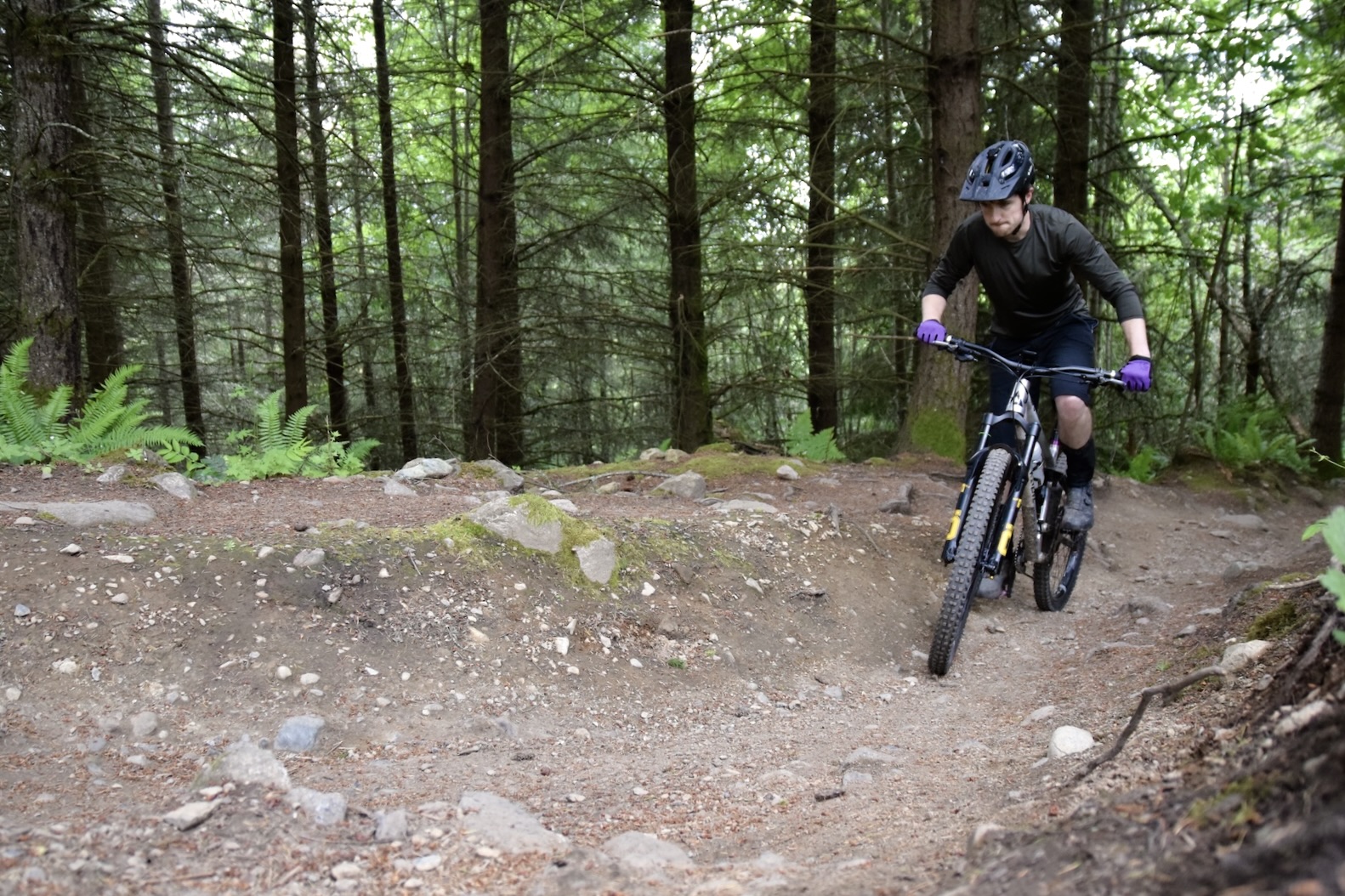
The VHP 16 is happy to sit and spin on fire roads, but it really manages to pull away from other bikes in the Enduro segment on steeper and rougher singletrack climbs. The chainstays grow slightly at sag (+11 mm in 29” mode and +15 mm in mixed wheel mode), which combines with the steep seat tube angle to center the rider’s mass and keep the front wheel tracking. Despite the high levels of anti-squat keeping the suspension riding high, the rear wheel still follows the ground well, lending plenty of grip as the rear wheel drives itself into the ground. I did feel that the 29” wheel was a bit more efficient than the 27.5” rear wheel, with better rollover characteristics and a tendency to preserve momentum more effectively, but it was a fairly minor difference. I did not feel the need to reach for the shock’s climb switch in any of the configurations that I tried, and I also didn’t notice any real downside to the idler — it was very quiet after wearing in a bit for the first couple of rides, doesn’t really add perceivable friction, and shows truly no signs of wear thanks to its stainless steel construction.
We said this about the V6 as well, but the one area where the VHP 16 gives up a bit of comfort is on flatter, rolling terrain. The 77.5° effective seat tube angle feels steep due to the actual seat tube angle being just 2 degrees slacker, and consequently, it can feel a little bit too in line with the bottom bracket on truly flat trails while putting more pressure on your hands as a result. Sliding the seat back slightly on the rails can go a good ways toward mitigating that feeling if it bothers you, but given the descending-oriented intentions of the VHP 16, I think the steeper seat angle is still the right call — the VHP 16 comfortably acknowledges that steep descents require steep climbs.
One big change from the V6 to the V7 is the modular dropouts, with +0, +10, or +20 mm options. Kavenz provided the +10, which is recommended for the Large and XL frames, along with the +20 as a longer option for experimentation. While the increased rear center length was somewhat noticeable going from +10 to +20 mm in terrain where placing the rear wheel required particular precision, the differences were fairly minor on the way up the hill. The high levels of anti-squat mean that the bike holds the rider’s mass under power, allowing me to stay quite centered on the bike even when scaling particularly punchy climbs.
Descending
Digging into the 77-Designz YouTube channel yields a wealth of content about the depths that Kavenz went to in designing the original VHP 16. The level of intentionality behind the suspension design and frame is very impressive and clearly a passion project — and that investment in development shows on the trail.
The rear suspension on the VHP 16 is, in a word, outstanding. It’s likely the product of high-quality bearings and proper frame alignment, but even pressing a finger on the saddle is enough to get the rear shock moving. That remarkably sensitive initial stroke ramps up in a predictably progressive fashion, all in a way that feels both supportive and forgiving. The suspension’s intuitive nature and rather linear progression made for easy setup of the rear shock without having to rely on large amounts of compression damping to overcome any particular shortcoming of the suspension kinematics. It also means that the VHP 16 plays nicely with both coil shocks and modern high-volume air shocks.
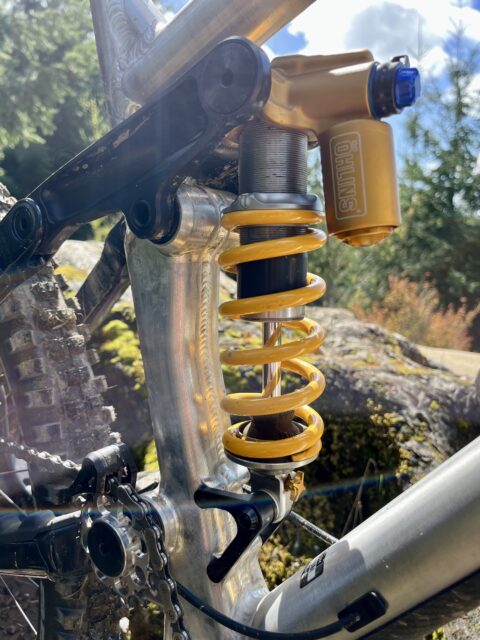
Paired with the supportive leverage curve, the rearward axle path afforded by the high pivot layout means that the VHP 16 tracks brilliantly in rough, natural terrain. The frame is adequately stiff but not jarringly so, and the suspension’s ability to track the ground without hanging up means that it makes quick work of medium-sized and square-edged hits that can cause headaches for some other bikes. I ride flat pedals most of the time, and the high pivot’s ability to smooth square-edged hits is awesome for helping to keep my feet planted when things get spicy. As is fairly common with high pivot bikes, the VHP 16’s suspension does bias slightly toward tracking the ground rather than encouraging popping and jumping over obstacles, but the supportive leverage curve still gives the bike a playful character — just not as much so as other bikes with non-high pivot layouts. What the Kavenz gains in exchange is a high level of forgiveness and grip in rough or slippery terrain.

Compared to some other bikes with slacker head angles and/or longer reaches, the Kavenz does not bring heaps of straight-line stability. The much longer Cotic RocketMAX stands out in my mind as an exceptional example of a bike that thrives when speeds are high, and even the slightly slacker Orbea Rallon offers a bit more stability than the VHP 16. The VHP 16 is certainly no slouch in that area, no doubt helped by the slightly longer chainstays now featured on the V7 versus the V6 we last tested, but what the VHP 16 loses in straight-line speed it gains in its ability to change directions quickly in more awkward terrain. I found the VHP 16 to be a very encouraging trail partner on less familiar routes — it was predictable, forgiving, and capable of making quick adjustments if I found myself in the wrong place in an awkward section of terrain. In that way, I think that the VHP 16 V7 is particularly appealing for more advanced riders who can take advantage of the extra maneuverability backed up by excellent suspension.
The VHP 16 also corners very well thanks to its low bottom bracket and centered stance. Steering through the feet feels intuitive and effective, with the weight balance between the front end rear wheels preventing over- or under-steer. Though the high pivot’s rear center growth is somewhat noticeable in particularly tight corners, it didn’t upset the weight balance enough to cause any issues.

One of the things I was particularly excited about with the VHP 16 was the ability to test full 29” and mixed wheel configurations with two different chainstay lengths. The modularity of the VHP platform means that making these changes was quite simple, the wheel size adjustment requiring a 3-bolt swap of a lower shock mount, and the chainstay length adjustment being a 4-bolt job with 2 bolts per dropout.
Every configuration we tested ended up being compelling in its own way, though my personal preference landed on two distinct configurations. The following sections unpack each of the four options we tested and my impressions of each:
29” / +10 mm dropouts
With the +10 mm dropouts, the 29” wheel setup on the VHP 16 feels similar in balance to the latest Orbea Rallon in full 29” mode. It allows for a centered riding stance and carries speed well, though the nature of the high pivot’s growing rear center is very slightly noticeable at first. This was the dropout length recommended by Kavenz for the Large frame, and I can see why — it provides a very balanced ride and is easy to get along with from the start.
29” / +20 mm dropouts
With the +20 mm dropouts, the increased rear center length is immediately noticeable on the trail. The longer chainstays make the rear end of the VHP 16 feel a bit “heavier,” requiring more deliberate steering through the feet to shift the back end around. The payoff is a boost in straight-line stability, which certainly could have its benefits in the right terrain, but given the otherwise agile nature of the VHP 16, I found the slower response of the rear end to be generally less fun and engaging than with the +10 mm dropouts.
27.5” / +10 mm dropouts
Unsurprisingly, the 27.5” rear wheel with the shorter +10 mm dropouts brought more playfulness to the rear end of the VHP 16. We’ve talked in other reviews about the tradeoffs of 27.5” rear wheels and they all exist here, too — the smaller rear wheel feels less locked in, more eager to take a tighter line through corners, and far easier to move around in the air compared to a 29” setup. While the high-pivot design of the VHP 16 goes a long way to mute square edge hits, I also found the 27.5” wheel’s smaller diameter to be just slightly less effective at carrying speed and muting impacts, likely due to the slightly reduced rollover capability.
27.5” / +20 mm dropouts
This configuration was the one that I was most curious to test and wound up being the one that most surprised me. Given the quick-to-turn, slashy nature of a 27.5” wheel compared to a 29” wheel in a given chainstay length, I had a hunch that pushing the chainstay longer than might be ideal for a 29” wheel could help to counter some of the aspects of the 27.5” wheel that I perceive as drawbacks. In the case of the VHP 16, I ended up having my theory confirmed. Paired with the +20mm dropouts, the 27.5” wheel exhibited more predictable cornering characteristics than with the +10 mm dropouts, feeling like it was slightly better at carving a similar arc to the 29” wheel up front. At the same time, it retained most, but not all, of the playfulness that the 27.5” wheel exhibited in the shorter +10 mm dropout setup, proving easier to toss around in the air and slash through steep, rutted trails than the 29” rear wheel.
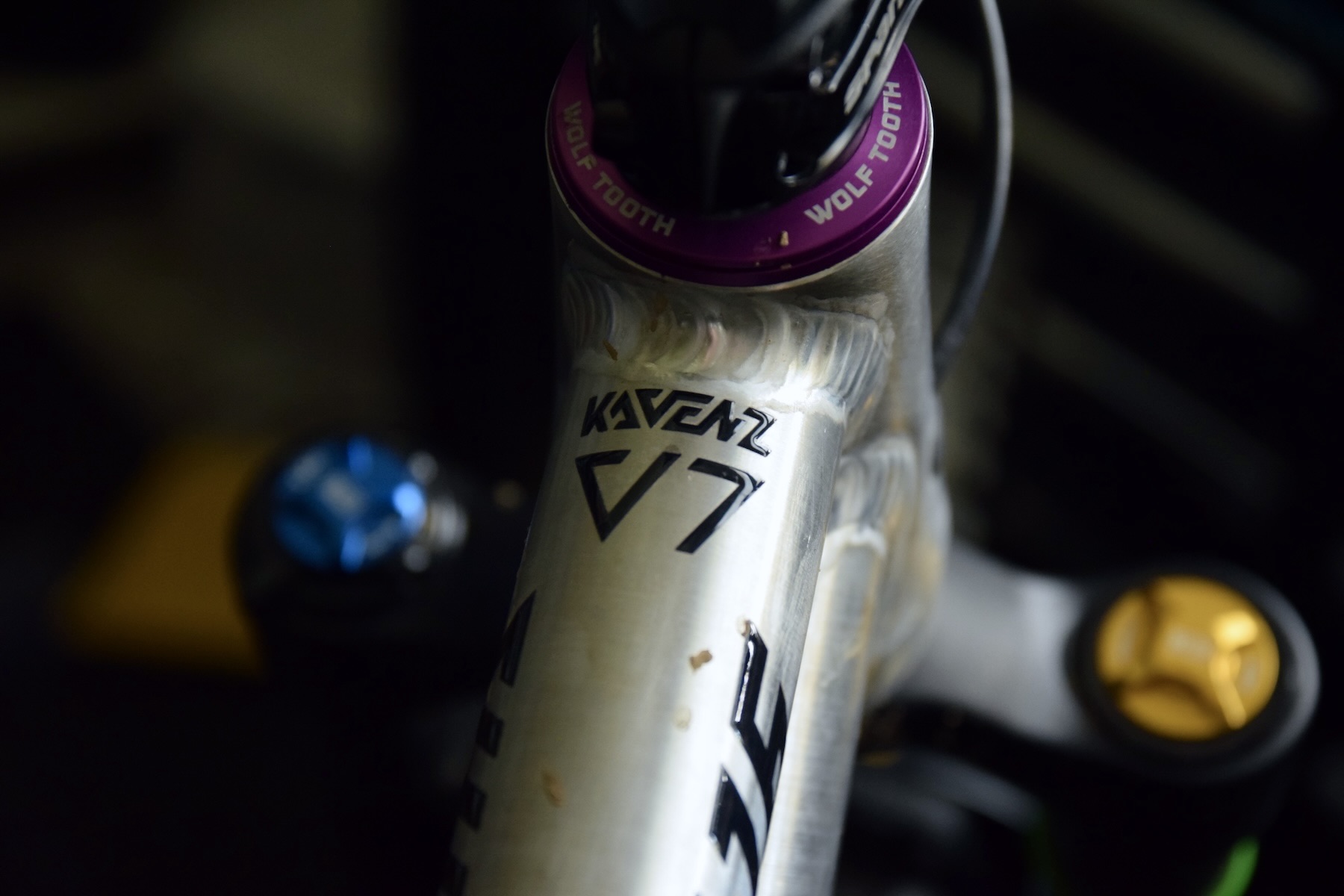
So, where does all of that experimentation leave us? Well, given my historical preference for bikes with full 29” setups, I was quite surprised with how much I enjoyed the 27.5” rear wheel in the longer +20 mm dropout configuration. Given the packaging advantages that a smaller rear wheel affords, it can feel almost counterintuitive to forego the opportunity to pack shorter chainstays into a bike, but I found the longer chainstays to blend some of the stability advantages often associated with a 29” rear wheel with the greater maneuverability of a 27.5” setup. The mixed wheel / long chainstay setup felt best on notably steep and technical trails where the 27.5” wheel was just a bit easier to place.
At the same time, I felt right at home on the +10 mm setup with a 29” rear wheel. The 29” wheel seems to climb more efficiently and roll over obstacles slightly better than the mixed wheel setup, and for my preferences, it feels very intuitive. It was my preferred setup on longer rides or on straighter, faster trails in more rolling terrain.
Given that I’m fortunate enough to be keeping this VHP 16 as my personal bike and parts testing bed for the foreseeable future, I will likely continue to switch between the +20 mm / 27.5” and +10 mm / 29” setups. The mixed wheel setup feels more inspiring on some of the steep trails that I frequent, and it’s a lot of fun to jump, but on longer rides in less demanding terrain, the 29” wheel wins out on efficiency. Ultimately, the VHP 16 V7 is a very interesting option in that it allows for this level of experimentation in the first place, but does not feel out of sorts in any of the various configurations that we tried.
The Build
Kavenz only sells the VHP 16 V7 as a frame kit. Riders can add a rear shock, with options from Fox, Intend, and EXT, and / or a fork from Fox or Intend. In our case, we received a bare VHP 16 frame and bolted up an Ohlins TTX22M.2 coil shock and RXF 38 M.2 fork. I also spent some time using both a Manitou Mezzer Pro and RockShox Super Deluxe Air, both of which also suited the VHP 16 well, though I did end up preferring the Ohlins fork in particular for its damper feel and added stiffness. Across the board, the welds, machining, and general assembly quality of the frame are truly exceptional — an example of German precision in bicycle form.
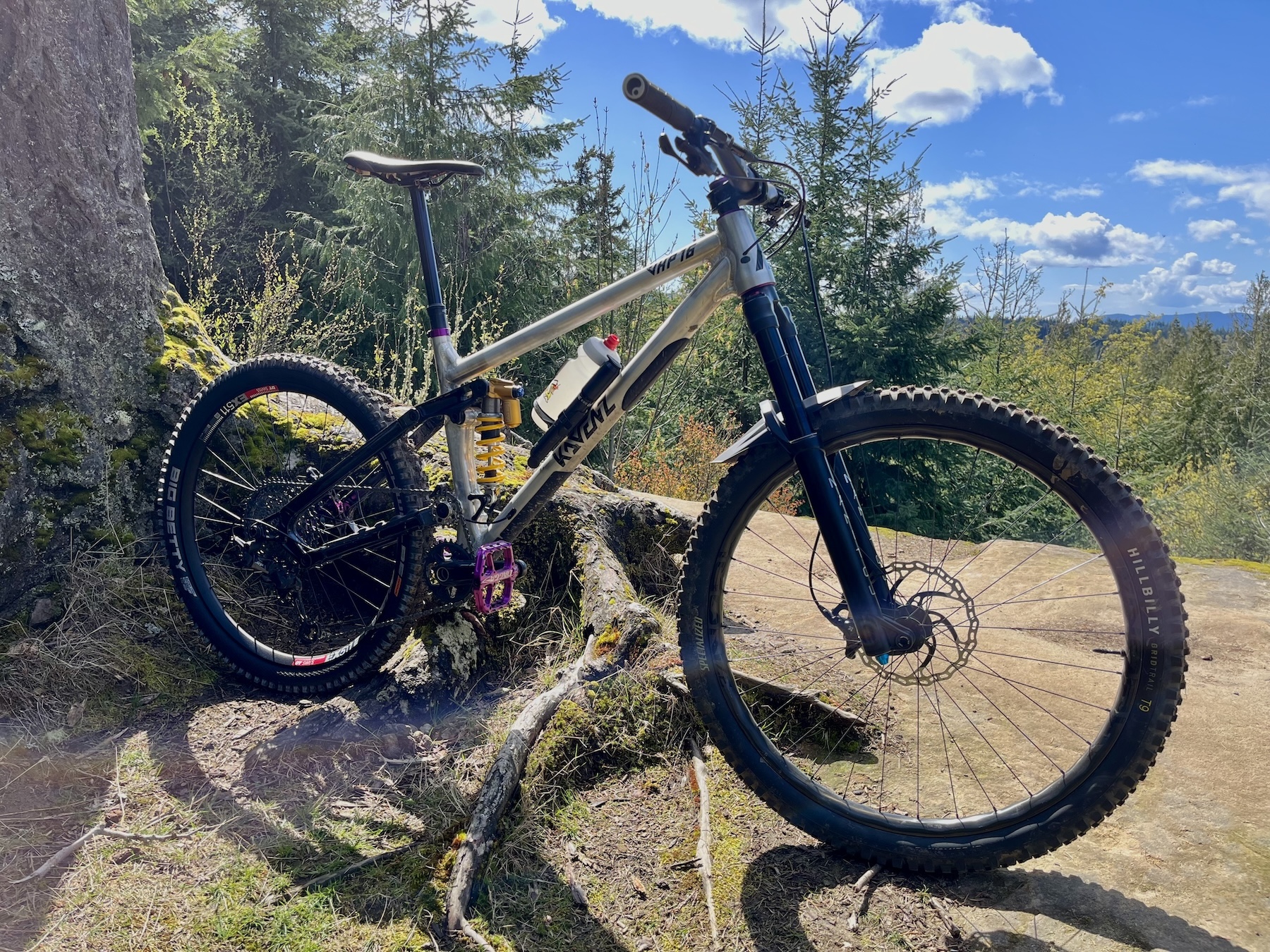
The Kavenz takes a 31.6 mm seatpost, a standard tapered headset, and a threaded 73mm bottom bracket, so buyers should have no problem finding just about any parts they desire. In our case, highlights from the rest of the build featured NOBL TR37 29” wheels and a Shimano XT drivetrain. A DT Swiss EX511 rim with a Spank Hex hub was used when running the bike in mixed-wheel mode.
Speaking more about the frame details themselves, Kavenz has done a great job with most of the finishing details. All hardware is titanium, bearings are the higher-end Enduro Black Oxide ones, and Kavenz includes plenty of documentation on torque specs — even where to apply grease vs. Loc-Tite. Kavenz also had the foresight to build a clever spacer-based adjustment system into both the high pivot’s pulley wheel and its chain guide to allow for easy chainline adjustment. That means that I was able to run a standard Boost setup, but could easily adapt the bike to a 55 mm chainline to work with SRAM’s Transmission.
My only real gripe with the frame design is the internal cable routing. Kavenz has some 3D printed fittings to secure cables where they enter and exit the frame at the rear triangle and lower main frame, but the cables exit the front of the bike at the headtube through small drilled holes. The headtube has 4 holes to accommodate standard or moto-style brake setups, but that also means that one hole will be unused. Kavenz includes a packet of Sugru, a nifty putty that hardens to a rubber and creates a DIY plug, but on a bike with so many well-sorted details, it feels a bit hack-y. Having all of the cables exiting in a fairly small area also means they run quite close to one another, requiring some zip tie or clip-on cable management to stop rattling. While the mechanic in me would love to see Kavenz try their hand at an external routing solution, I personally think the internal routing would be more cleanly executed if the cables exited the sides of the down tube via the same 3D printed fittings used at the lower cable ports.
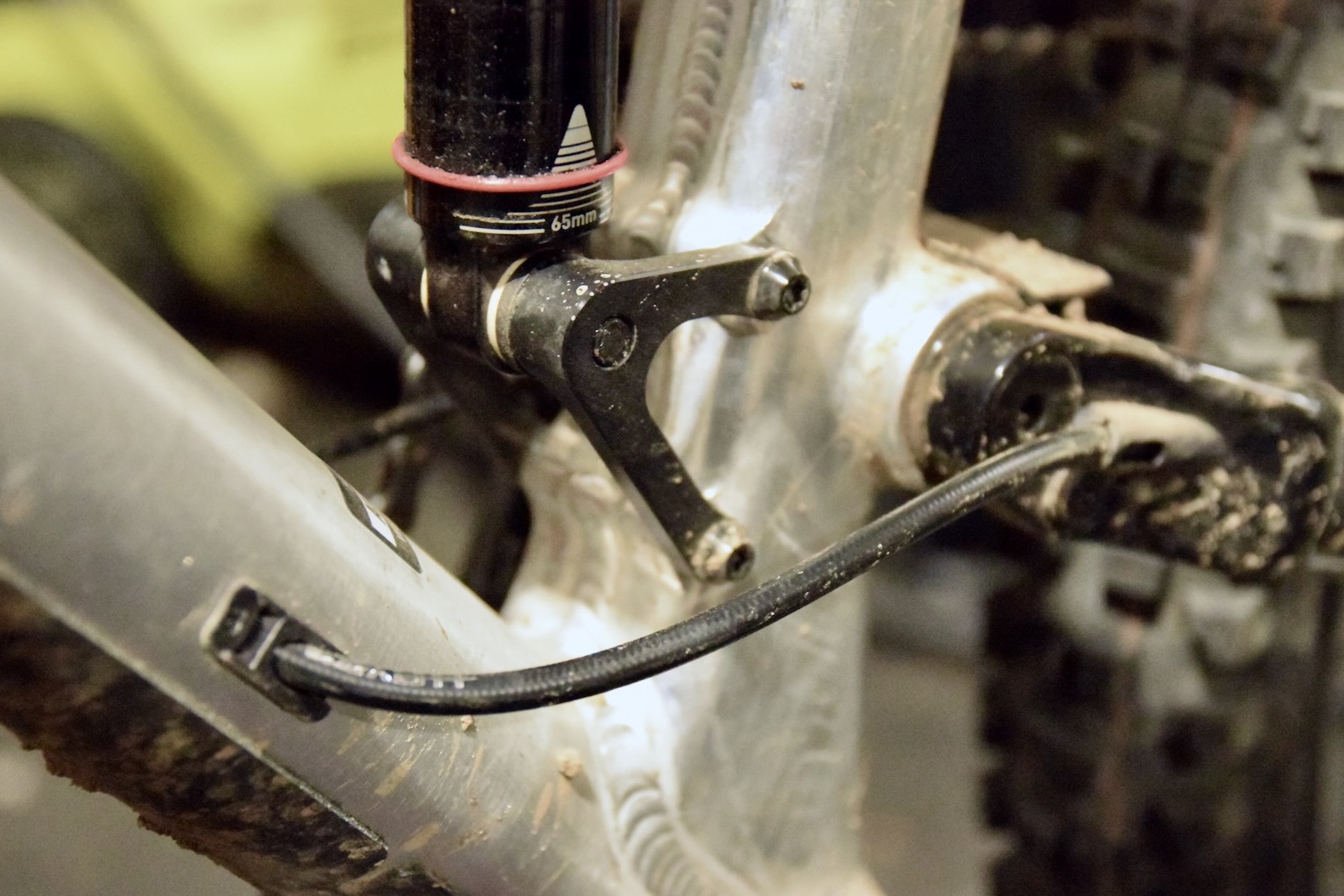
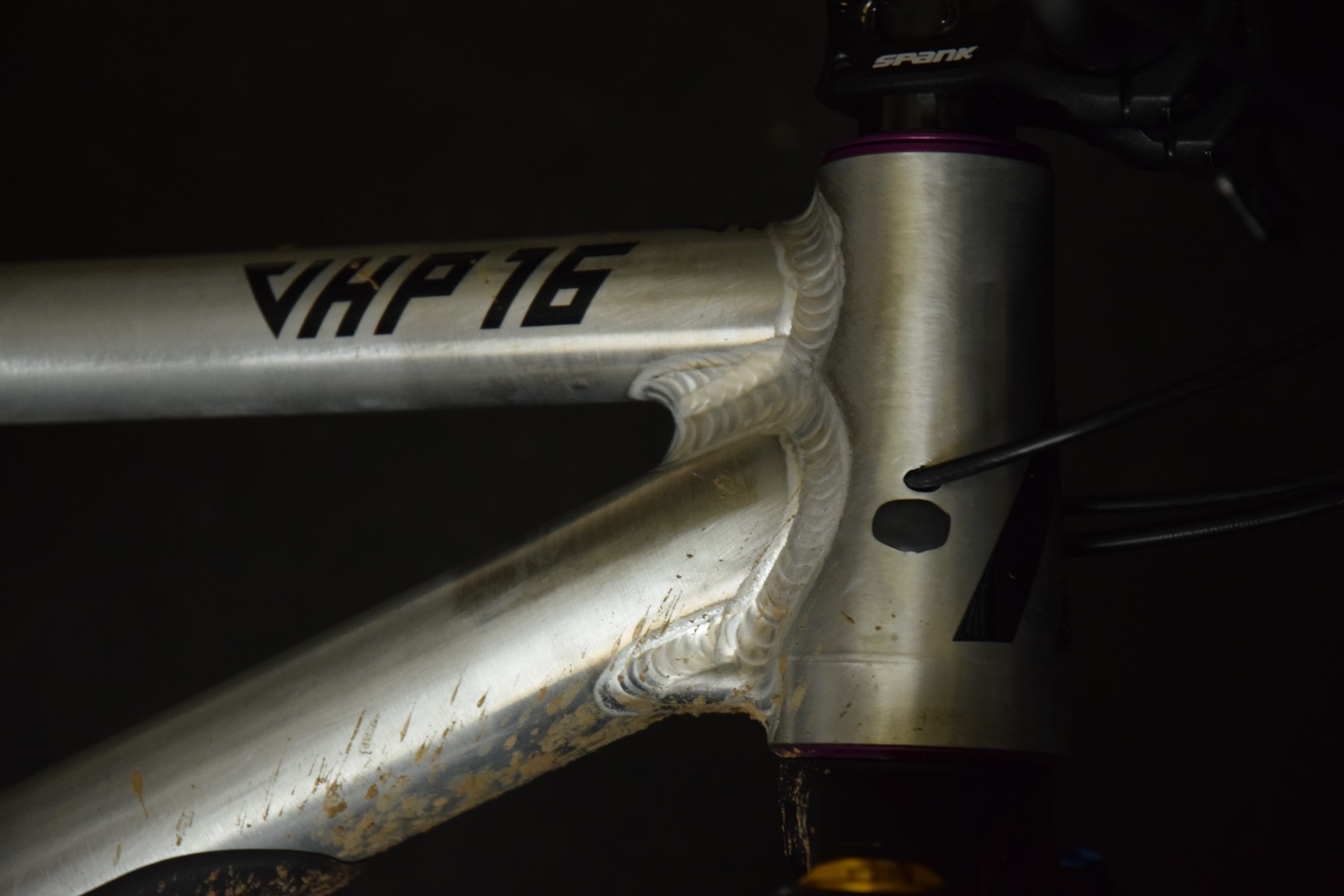
As a final note, though Kavenz can powder coat your VHP 16 in just about any color under the sun (or anodize it black), there’s a lot to be said in favor of the truly raw aluminum front triangle from a durability standpoint. I should note that Kavenz does recommend that folks living in a highly salty marine environment opt for a powder coated or anodized finish. I ended up adding some additional protective tape to the rear triangle as low-cost cosmetic insurance, but the combination of the raw front triangle and simple black painted rear triangle means that the bike should be easy to keep looking good for a long time.
Who’s It For?
This is a tricky one because of just how adaptable the VHP frame platform is — with different shock mount and shock size selections, the same frame can be turned into a 120 mm light trail bike or a 180 mm bike park brawler. While that might appeal to folks who want the option of several bikes in one frame, the VHP 16 we reviewed is a highly versatile option in itself. The VHP 16 pedals very well, and while the very effective suspension sits on the slightly more planted side of the spectrum, the geometry makes for a surprisingly agile ride that changes direction more effortlessly than one might expect from a high-pivot Enduro bike.
The VHP 16’s combination of highly effective suspension and a slightly more maneuverable ride feel mean that it’s not the best example of a squishy and stable Enduro couch that saves your bacon at the bike park. It’s not that the VHP 16 is demanding to ride when things get rough; rather, it’s just much more rewarding to ride for advanced riders who can take advantage of its precise and snappy handling.
Kavenz plays up the race-ready capability of the VHP 16, and while it certainly has a lot of the qualities that could make for a formidable Enduro race weapon, I see it as having broad appeal for riders who seek out technical trails and value the unique combination of an agile ride paired with a very capable and forgiving suspension system.
Bottom Line
While the heart of the VHP frame platform carries over from the V6 iteration we reviewed a couple of years ago, the VHP 16 V7 is Kavenz’s most refined model yet. It may be a rare sight on the trails, but the German-made VHP 16’s combination of often disparate traits make it a potentially peerless option for the right rider. While it doesn’t demand it, the VHP 16 certainly rewards a directive riding style, and for more advanced riders who can leverage its agility toward opening up line choices, it offers a standout combination of precision and poise.
Deep Dive Comparisons
BLISTER+ members and those who purchase our Digital Access Pass can check out our Deep Dive comparisons linked below. Get our Digital Access Pass to view all our Deep Dives and Flash Reviews, or become a BLISTER+ member today to get access to that and a LOT more, including the best worldwide Outdoor Injury Insurance, exclusive deals and discounts on skis, personalized gear recommendations from us, and much more.
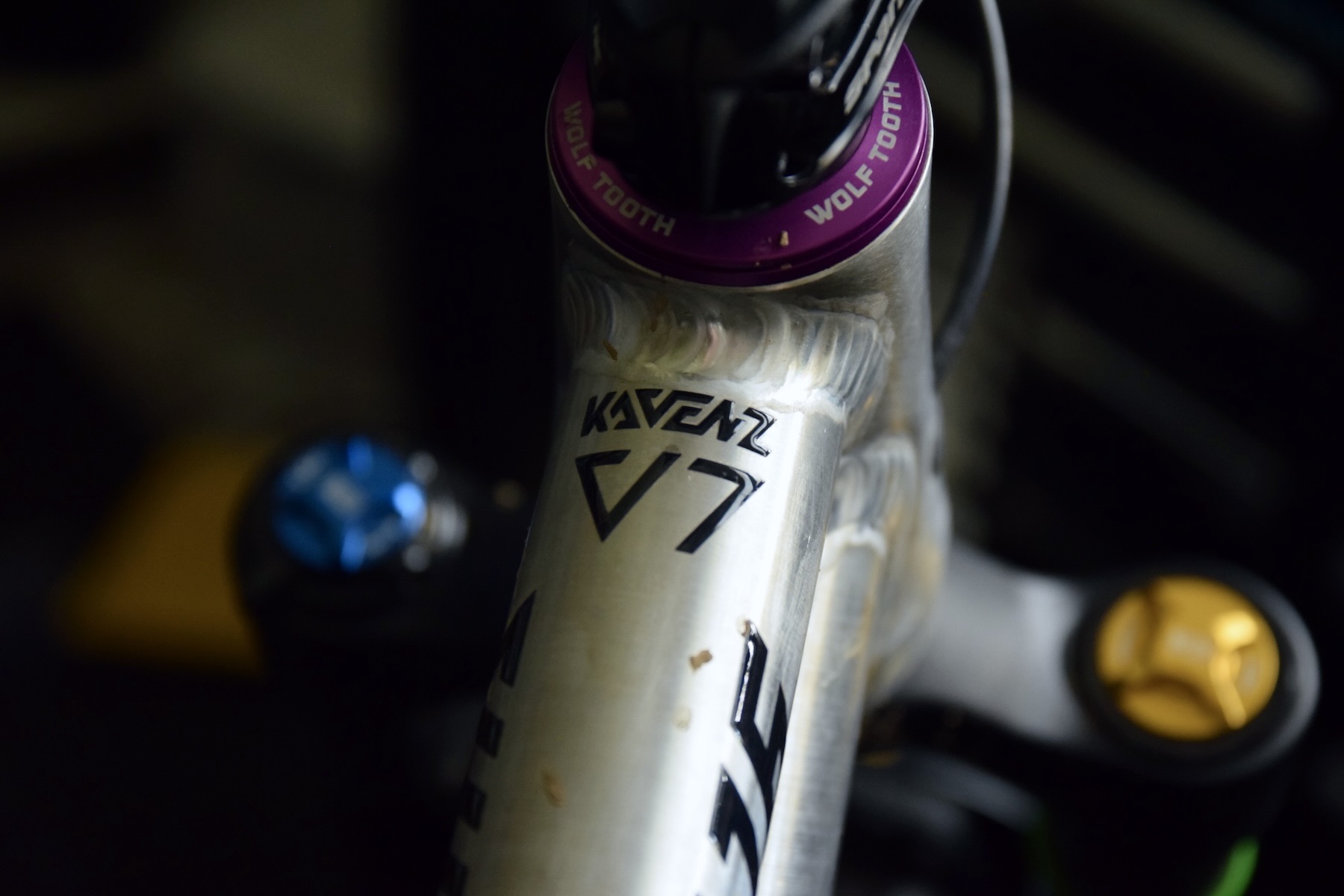
Deep Dive: Kavenz VHP 16 V7
We compare the Kavenz VHP 16 V7 to the Yeti SB165, Orbea Rallon, Ibis HD6, Deviate Highlander II, Raaw Madonna V3, Banshee Titan, and Specialized Enduro.
Blister’s Flash Reviews and Deep Dives are accessible to those who purchase one of our paid subscriptions
To get our comprehensive Deep Dives and our initial, unfiltered reports on new gear, become a member and receive many other services, deals, and discounts.
If you’re already an active member, please log in.
(If you’re already logged in and a member in good standing and seeing this message in error, please refresh this page in your browser.)

Banshee Titan a relevant comp?
I’ve spent some time on the Banshee Titan and currently own a Kavenz. I would say they are pretty comparable in many ways. The bikes ride similarly and it’s easy to switch between them. If you like the long chain stays of the Banshee you’ll like the Kavenz with +10 or +20 dropouts. The suspension on the Kavenz works better and is easier to set up. The Kavenz axle path makes it ride smoother. Kavenz also doesn’t have the shock clearance issues of the Banshee. Both are excellent bikes but I like the Kavenz better.
Apologies for missing this question, but Matt’s comment is fairly aligned with my experience — I owned a Titan for a couple of years. Our Deep Dive article has a comparison as well, but the short answer is that the Titan feels a bit shorter and taller than the Kavenz, with a shorter reach (470 mm on a Large), less standover clearance, and a higher bottom bracket. The Titan has excellent suspension performance, but the Kavenz beats it out slightly for being a bit more composed at high speeds. The Titan does feel a bit more “poppy” and eager on jump lines, perhaps because it doesn’t have the growing rear center associated with the VHP’s high pivot design.
The Kavenz feels more ground-hugging and would be a better race bike, where the Titan feels more Freeride-inspired, but both excel on rough and steep trails while pedaling quite well.
Just circling back to thank you both for these thoughtful replies. Very helpful in thinking about my next enduro frame, which is still TBD. I did end up going with a Banshee Prime for my mid-travel trail bike, partly because I think the Banshee suspension characteristics you describe will better suit that category of bike as well as my ride style & terrain.
Can you tell me the shock tune on the RockShx Super Deluxe Air you used with the bike? I have one in my Kavenz as well but it does not perform very nicely at the moment.
It’s the 2023 Super Deluxe Ultimate with the Linear air can, L1 compression and LNL rebound tunes. I’m running the rebound fairly fast and fairly high compression damping. I still like the Ohlins coil slightly better, but the air shock adds some liveliness to the suspension for sure.
PNW V5 VHP18 owner here. I purchased the new chain-stays and tried all 3 chain stays lengths, VHP16, VHP18, with mullet and 29er. I couldn’t agree more on how these change the ride characteristics. My current favorite setup is 180/180 mullet with the +20 chainstays. The options are endless and I’m constantly trying different setups which makes it feel like I have multiple bikes which is sweet!
Epic review. Had I realized the modular dropouts were available I might have ordered this over the V2 Dreadnought. Interested to hear how the two compare when you manage to get your hands on the Forbidden given the similar modularity for wheel size and chainstay length.
Shoot… had a closer look at the geo chart and it looks like the 513mm reach “2XL” is listed as having 445mm chainstays INCLUDING the +20mm dropouts. If we assume the L (480mm reach) is their “designed case” with the intended geo/performance, the 2XL would then need 456mm chainstays to have the same front center / rear center proportions as the L. Given that there’s no way to make the chainstays longer I think I’d have to pass. Hoping more companies join Forbidden in the world of truly proportional geo – not a lot of options currently for folks at either end of the height spectrum.
They might add +30mm option and longer headtube.
Worth noting that per Kavenz, the author’s custom size Large+ (480 reach + 125 HT) in fact does not have a 480 reach- they use existing tubes and by slapping a longer HT on the existing 480 reach top tube it actually becomes a 473 reach. This is why the reach makes an irregular size jump with the actual size XL (493) making a 13mm jump instead of a 20mm. Because the geo is based on the 110 HT and when it goes to 125 reaches get shortened by 7mm. If they add a 135mm HT option it would shorten the reach even further.
Personally for stack I think the better option is to switch from a ZS to a EC lower cup, which will increase stack, still alter reach but not as much as semi custom (which per Kavenz is literally just having a 110 HT with 15mm spacers), but also will allow for further modifications like a cane creek angle set to alter both reach and HTA. Also with options for high rise bars going up to 80mm rise with more “moderates” down to 50mm all we are debating at this point is aesthetics. Essentially whether you prefer a boatload of spacers and a “normal” looking bar, or chopper bars with no spacers. Super high rise bars are more interesting as far as reach and feel being even more alterable because the roll of such handlebars can affect reach and contact points way more than less rise bars because the roll provides so much more movement.
This is a great callout and makes complete sense if Kavenz is using the same top tube. I was able to confirm this to be the case and added a note to the review. Though it wasn’t made clear when we received our test bike, it does some way toward explaining why the slightly longer 45 mm stem feels better for me overall. This does also make me wonder if Kavenz might explore adding a 1.5” headtube down the line to allow for reach adjustment headsets, as it would further increase customization of the reach to suit each rider.